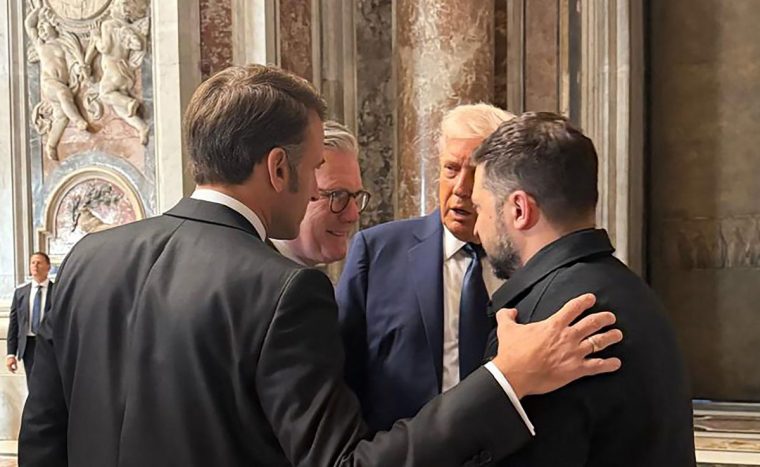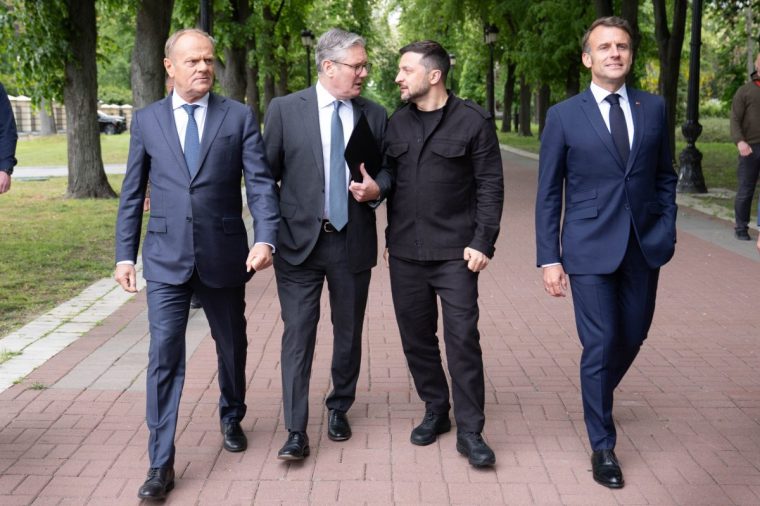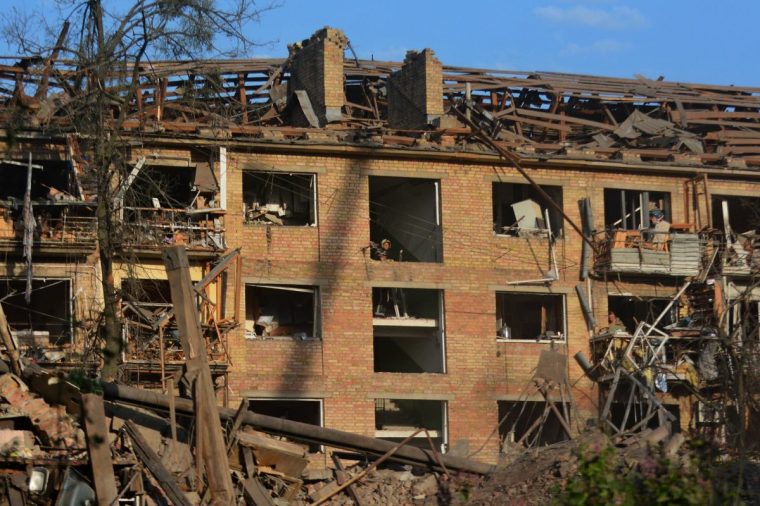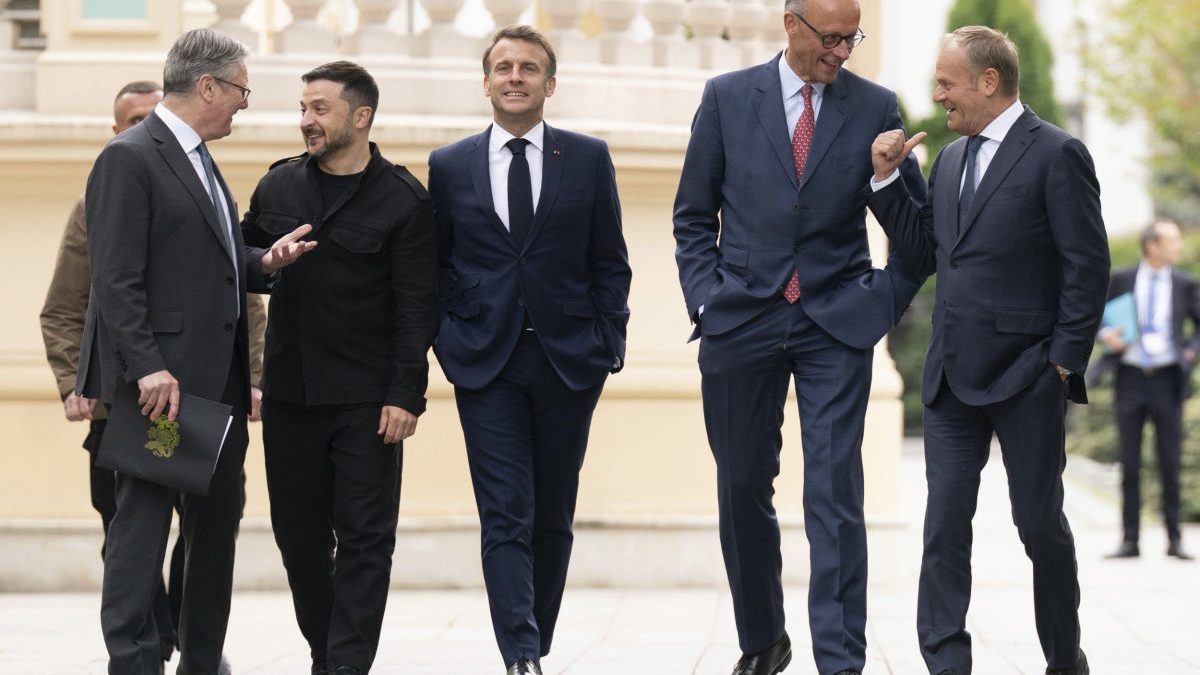European leaders are in Ukraine and have lavished praise on Trump for his role in the ceasefire talks
British Prime Minister Sir Keir Starmer was in Ukraine with his European counterparts on Saturday to pressure Russia into accepting a 30-day ceasefire.
Starmer travelled by train with French President Emmanuel Macron and the new German chancellor Friedrich Merz, with Polish Prime Minister Donald Tusk and Ukrainian President Volodomyr Zelensky joining them in Kyiv.
The trip is designed to show support and solidarity with Ukraine after 20 world leaders joined Victory Day celebrations in Russia this week.
But it has also acted as a strong display of unity with the US, after somewhat fractured relations since Donald Trump re-entered the White House in February. He had a public spat with the Ukrainian President in the Oval Office and has, until recently, appeared favourable towards Russia’s leader Vladimir Putin.
The US President is now firmly backing a push for a 30-day ceasefire from Monday so peace talks can begin and held a call with Starmer and the other European leaders on Saturday.
In a joint statement, the European group said they “reiterate our backing for President Trump’s calls for a peace deal” and that “alongside the US, we call on Russia to agree a full and unconditional 30-day ceasefire”.
They threatened Russia with “massive” new sanctions if it failed to comply.
Finally, it seems, Europe and the US are pulling in the same direction over Ukraine. But will it be enough to pressure Putin into a deal?
Trump cooling on Putin as relations with Europe thaw
Since retaking office, Trump has veered dramatically from Europe’s stance on the conflict, blaming Ukraine for starting the war, temporarily withholding intelligence from Kyiv and threatening to pull military support, as well as hinting that he would withdraw from the Nato military alliance altogether.
But his relationship with Putin has cooled in recent weeks, with Trump making a series of public criticisms as he grows frustrated at the Kremlin’s unwillingness to end the war.
The Europeans say they have held productive calls with Trump in recent days and defence insiders say there is currently no indication that the US President is reducing his support for, or withdrawing from, Nato. He has also threatened fresh sanctions on Russia.
 Zelensky (right) briefly met with French President Emmanuel Macron (left), Sir Keir Starmer (second left) and Trump during Pope Francis’s funeral (Photo: Office of Ukrainian Presidential Press Service via Getty)
Zelensky (right) briefly met with French President Emmanuel Macron (left), Sir Keir Starmer (second left) and Trump during Pope Francis’s funeral (Photo: Office of Ukrainian Presidential Press Service via Getty)
The gaping divide between the US and Europe over the talks appears to have closed – for now.
 European leaders meet with Zelensky at the Presidential Palace in Kyiv, Ukraine on Saturday. (Photo: Stefan Rousseau/PA)
European leaders meet with Zelensky at the Presidential Palace in Kyiv, Ukraine on Saturday. (Photo: Stefan Rousseau/PA)
Dr Neil Melvin, director of international security at defence think tank Rusi, said rhetoric around the trip appeared to show a “realignment” away from Putin and towards Europe.
Melvin said that the European strategy following the “disastrous meeting” between Trump and Ukraine’s President Zelensky in the Oval Office had been to get behind America’s approach and lavish praise on the White House, while trying to steer the terms of any agreement in Ukraine’s favour.
“Now what we’re seeing is that the Russians look like they may have overplayed their hand. They haven’t really given anything. I think Trump is starting to realise actually, the biggest barrier to a peace deal is not actually Kyiv, but Moscow.”
America’s backing of Ukraine could pressure Putin
Despite the change in Trump’s position, a ceasefire is by no means imminent.
Russia has already indicated it will not consider the US’s proposed 30-day ceasefire unless the West halts arms supplies to Ukraine, which is intolerable to Kyiv’s allies.
The Kremlin is widely considered to be stalling talks, with little incentive to bring the conflict to a close.
One Ukrainian soldier told The i Paper he believed that Russia was “absolutely not serious about peace” because it was “winning in every aspect” so had no reason to bring the war to an end.
He believes that Putin is only appearing to entertain talks to win favour from Trump, who had pledged to end the war “on day one” of his presidency.
However, Melvin said that if the US throws its weight behind Ukraine again, it may help tip the balance in favour of Kyiv, and enable Zelensky to continue the war until Russia is exhausted.
 A residential building in Svyatoshynskyi district which has been badly damaged by the Russian missile strike (Photo: Oleksandr Gusev/Global Images Ukraine via Getty)
A residential building in Svyatoshynskyi district which has been badly damaged by the Russian missile strike (Photo: Oleksandr Gusev/Global Images Ukraine via Getty)
“We’ve already seen signs that United States is ready to start to resupply Ukraine with weapons, provided Ukraine buys them rather than being given them as a basis for loans or even gifts. There’s been talk that the United States may re- examine the sanctions on Russia,” Melvin said.
“The issue now is: will the United States actually swing behind Ukraine and use strategies to put pressure on Moscow to reach a peace deal, and to strengthen Ukraine? That will make a difference.”
Melvin said that Putin’s war machine may still have the upperhand but it is also “struggling” and they are making little progress on the battlefields.
“It’s costing a lot of people and equipment, and the Russian economy is starting to run out of the ability to sustain this. I think the longer this goes on, particularly into next year, things start to look much darker for Putin at that point.
“The dial may start to shift a little bit more towards pressure on Russia, the longer that this solidarity with Ukraine remains in place.”
Sanctions needed to hamstring Putin
On Friday, the UK announced sanctions on Russia’s shadow fleet, taking action against up to 100 oil tankers that have been carrying cargo said to be worth more than $24bn in defiance of sanctions.
The European leaders said that Putin would be hit with “massive” new sanctions if he did not agree to the 30-day ceasefire.
These would likely be secondary sanctions, in which the US and Europe target countries facilitating Russia’s war by buying its products such as oil.
This would impact Russia’s ability to fund its invasion and to recruit new soldiers with the promise of cash.
However, the White House has not indicated when – or if – these sanctions would be imposed, and Melvin said it could be more difficult than Trump would like.
“Some of the targets that have been, at least hypothetically, thought about have been countries like India, because they’ve been buying a lot of Russian oil at very cheap prices,” Melvin said.
“The problem is that it’s going to be a very difficult political message, because you’re not just sanctioning Russia. You’re going after countries who may not feel that this is really their fault; they’re just buying oil on world markets against the backdrop of an already very tough situation around this global tariff war that Trump started.
“I think that that instrument looks more complicated than perhaps the Trump administration initially thought it would be.”
